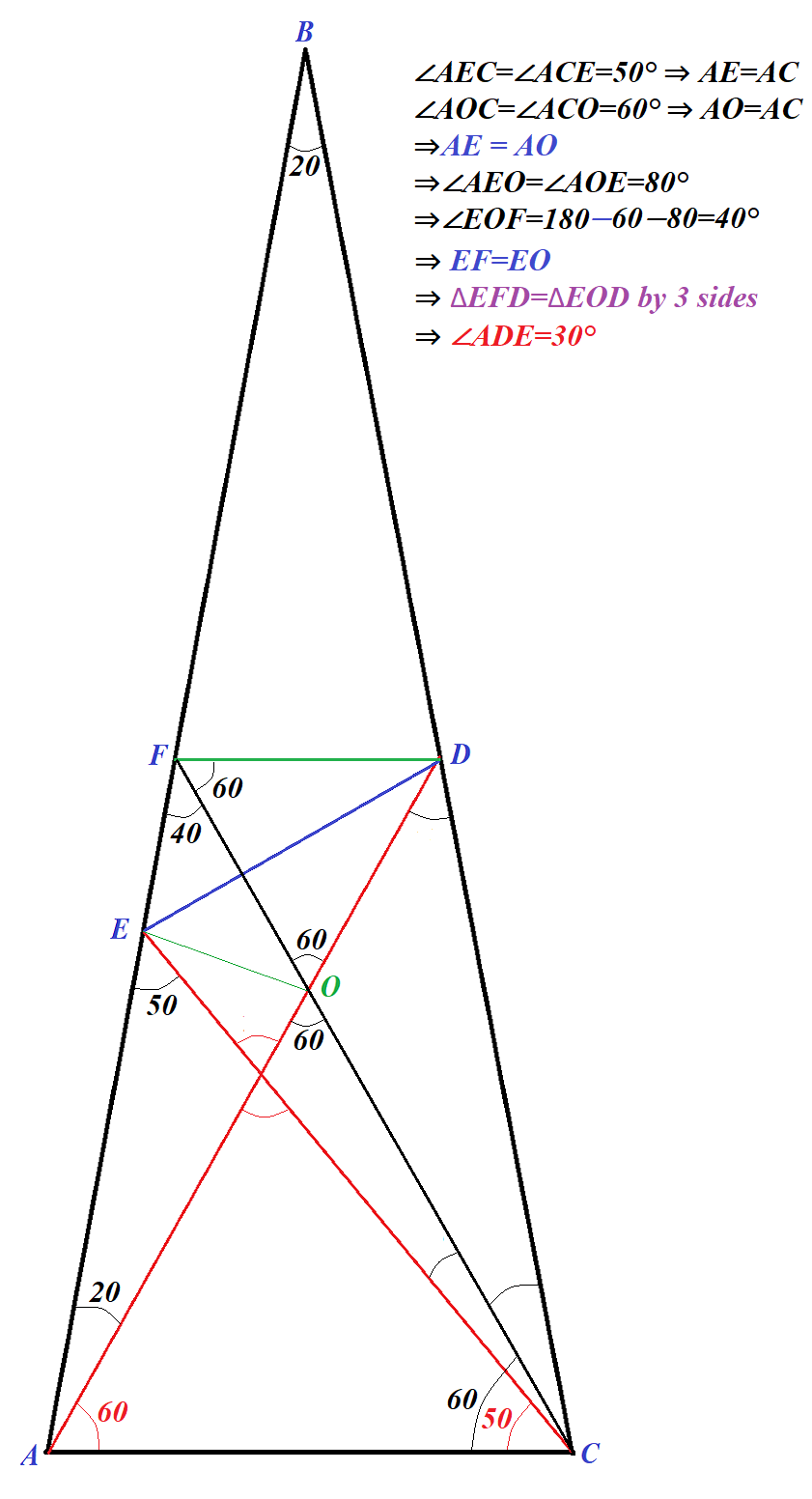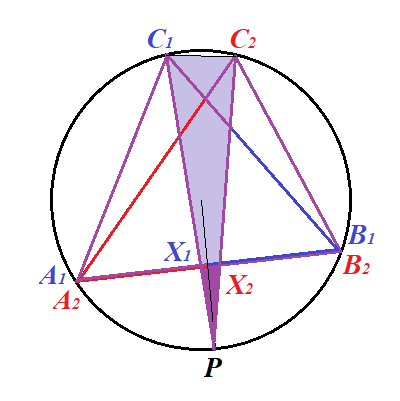Geometry+ 06
Problem A
Given an isosceles triangle ΔABC with AB=BC and ∠ABC=20°.
Point D on side BC is chosen such that ∠CAD=60°.
Point E on side AB is chosen such that ∠ACE=50°.
Find angle ∠ADE.
Solution A

Problem B
Given two triangles ΔA1B1C1 and ΔA2B2C2 with the following properties:
(a) side A1B1 of the first triangle equals to side A2B2 of the second;
(b) angles opposite to these sides, ∠A1C1B1 and ∠A2C2B2, are equal to each other;
(c) bisectors of these angles, C1X1 and C2X2, are also equal to each other.
Prove that these triangles are congruent.
Proof
Put side A1B1 on top of A2B2 and draw a circle around ΔA1B1C1.
Obviously, point C2 would lie on this circle because of equality of angles opposite to equal sides.
Assume that points C1 and C2 do not coincide.
Extend bisectors C1X1 and C2X2 to intersection with a circle at point P. It must be the same point for both bisectors because each divides the arc ⌒A1B1 in half.

First, let's prove that triangle ΔPC1C2 is similar to triangle ΔPX1X2
Our proof will be based on congruency of two angles of one triangle to two corresponding angles of another.
For brevity, when we use an expression "angle is measured by an arc (or a fraction of it)", we mean that this angle is equal to a central angle subtended (supported) by this arc (or a fraction of it).
We will also use known theorems of Geometry:
(Theorem 1) An angle inscribed into a circle (that is, formed by two chords with one common point on a circle) is measured by half an arc it cuts from a circle by its two rays.
(Theorem 2) An angle formed by two chords intersecting inside a circle is measured by half of a sum of two opposite arcs these chords cut.
These theorems were presented in UNIZOR.COM - Math 4 Teens - Geometry - Circles - Mini Theorems 1 and ...Mini Theorems 2.
1. ∠PC1C2 is measured by half of sum of arcs ⌒C2B2 and ⌒B2P;
∠PX2A2 is measured by half of sum of arcs ⌒C2B2 and ⌒PA2;
but arcs ⌒B2P and ⌒PA2 are equal, from which follows that
∠PC1C2 equal to ∠PX2A2.
2. ∠PC2C1 is measured by half of sum of arcs ⌒C1A2 and ⌒A1P;
∠PX1B1 is measured by half of sum of arcs ⌒C2B2 and ⌒PA2;
but arcs ⌒B2P and ⌒PA2 are equal, from which follows that
∠PC1C2 equal to ∠PX2A2.
Since two angles of ΔPC1C2 are congruent to two angles of ΔPX1X2, these triangles are similar.
Consequently, their sides are proportional
PC1/PX2 = PC2/PX1
If angle bisectors C1X1 and C2X2 are equal, segments C1P and C2P must be equal to preserve the proportionality of corresponding sides of triangles ΔPC1C2 and ΔPX1X2.
Indeed, if C1X1=C2X2=d, PX1=x1 and PX2=x2, then
(d+x1)/x2 = (d+x2)/x1
⇒ d·x1+x1² = d·x2+x2²
⇒ d·(x1−x2) = (x2−x1)·(x1+x2)
⇒ x1 = x2, because otherwise d would be negative −(x1+x2).
From C1P = C2P follows
⇒ ⌒C1A1P = ⌒C2B2P
⇒ ⌒C1A1 = ⌒C2B2
⇒ C1A1 = C2B2
Analogously,
⇒ C1B1 = C2A2
which proves that triangles ΔA1B1C1 and ΔA2B2C2 are congruent by three sides.


No comments:
Post a Comment